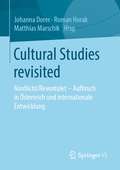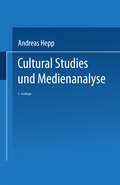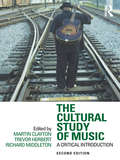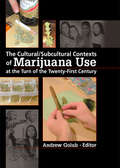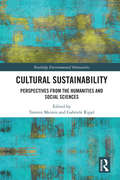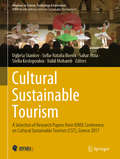- Table View
- List View
The Cultural Studies Reader (PDF)
by Simon DuringThe Cultural Studies Readeris the ideal introduction for students. A revised introduction explaining the history and key concerns of cultural studies brings together important articles by leading thinkers to provide an essential guide to the development, key issues and future directions of cultural studies. This fully updated third edition includes: 36 essays including 21 new articles An editor's preface succinctly introducing each article with suggestions for further reading Comprehensive coverage of every major cultural studies method and theory An updated account of recent developments in the field Articles on new areas such as culture and nature and the cultures of globalization New key thinkers such as CLR James, Gilles Deleuze, Antonio Negri and Edward Said, included for the first time The Cultural Studies Readeris designed to be read around the world and deals with issues relevant to each continent
Cultural Studies revisited: Nordlicht/Revontulet - Aufbruch in Österreich und internationale Entwicklung
by Johanna Dorer Roman Horak Matthias MarschikDieses Buch präsentiert Cultural Studies, beginnend mit der österreichischen Aufbruchsstimmung und begleitet von internationalen Stimmen der Tagungsteilnehmer*innen in Tampere und Birmingham. Es zeigt die vielfältige Forschungswelt der Cultural Studies bis heute und schlägt Brücken in die Zukunft.Cultural Studies waren ein Versprechen und vielleicht auch eine wissenschaftliche Verheißung. Im wahrsten Wortsinn erschienen sie, als in Finnland die ersten internationalen Tagungen stattfanden, wie ein Nordlicht am Horizont: Revontulet. Die Crossroads-Konferenzen in Tampere (1996, 1998) und Birmingham (2000) waren für Wissenschaftler*innen der Beginn eines interventionistischen Wissenschaftsprojekts, das in Wien seinen Ursprung im Institut für Kulturstudien (IKUS) hatte.
Cultural Studies und Medienanalyse: Eine Einführung (Medien • Kultur • Kommunikation)
by Andreas HeppIIn „Cultural Studies und Medienanalyse“ wird der medienanalytische Ansatz der Cultural Studies umfassend vorgestellt. Bezogen auf den Gegenstand„Medien“ werden einerseits die Theorieansätze der Cultural Studies diskutiert und ihre forschungsgeschichtliche Entwicklung bis heute dargelegt. Andererseits werden die empirischen Studien der Cultural Studies aus den Bereichen der Produkt- und Diskursanalyse sowie der Rezeptions- und Aneignungsforschung ausführlich behandelt. In der dritten Auflage wurde das Buch im Hinblick auf die jüngste Forschung aktualisiert und erweitert.
Cultural Studies und Pop: Zur Kritik der Urteilskraft wissenschaftlicher und journalistischer Rede über populäre Kultur
by Ralf HinzIn den letzten Jahren wächst die Bereitschaft, sich populärer Kultur mit Kategorien ästhetischer Urteilskraft zu nähern. Vorreiter dieser neueren Entwicklung, mit der die ausschließliche Betrachtung der Jugend- und Popkultur als soziologisches Phänomen überwunden werden soll, sind die hier ausführlich behandelten anglo-amerikanischen Cultural Studies. Besonderes Augenmerk richtet man dort auf ungewöhnliche, subkulturelle Rezeptionsweisen populärer Kultur. Demgegenüber liegt der elaborierten journalistischen Rede über Popkultur die Annahme zugrunde, daß deren Produkte unmittelbar ästhetischen, sinnlichen Genuß gewähren. Auf dieser Basis erhebt sich dann eine intellektuell ambitionierte, gleichwohl betont unakademische Pop-Theorie, deren bislang noch nicht geschriebene Geschichte hier zu erzählen ist.
Cultural Studies Vol 18 1 Jan 2
by Various AuthorsCultural Studies examines how cultural practices relate to everyday life, history, knowledge, ideology, economy, politics, technology and the environment. Volume 18 from the 2nd January 2014.
Cultural Studies Vol 18 1 Jan 2
by Various AuthorsCultural Studies examines how cultural practices relate to everyday life, history, knowledge, ideology, economy, politics, technology and the environment. Volume 18 from the 2nd January 2014.
Cultural Studies Vol18 Issue 2
by Various AuthorsIssue 2-3 (2004) includes articles on rethinking everyday life, the myth of everyday life, the persistence of everyday, everyday tragedy and creation, time and space in everyday life, everyday utopianism, profane illuminations, a different life - looking at Barthes and Foucault, rountine and ambiguity, shame, prescences, a mundane voice, limitations; and consumption of digital commodities in everyday life to name a few.
Cultural Studies Vol18 Issue 2
by Various AuthorsIssue 2-3 (2004) includes articles on rethinking everyday life, the myth of everyday life, the persistence of everyday, everyday tragedy and creation, time and space in everyday life, everyday utopianism, profane illuminations, a different life - looking at Barthes and Foucault, rountine and ambiguity, shame, prescences, a mundane voice, limitations; and consumption of digital commodities in everyday life to name a few.
The Cultural Study of Music: A Critical Introduction
by Trevor Herbert Richard Middleton Martin ClaytonWhat is the relationship between music and culture? The first edition of The Cultural Study of Music: A Critical Introduction explored this question with groundbreaking rigor and breadth. Now this second edition refines that original analysis while examining the ways the field has developed in the years since the book’s initial publication. Including contributions from scholars of music, cultural studies, anthropology, sociology, and psychology, this anthology provides a comprehensive introduction to the study of music and culture. It includes both pioneering theoretical essays and exhaustively researched case studies on particular issues in world musics. For the second edition, the original essays have been revised and nine new chapters have been added, covering themes such as race, religion, geography, technology, and the politics of music. With an even broader scope and a larger roster of world-renowned contributors, The Cultural Study of Music is certain to remain a canonical text in the field of cultural musicology.
The Cultural Study of Music: A Critical Introduction
by Trevor Herbert Richard Middleton Martin ClaytonWhat is the relationship between music and culture? The first edition of The Cultural Study of Music: A Critical Introduction explored this question with groundbreaking rigor and breadth. Now this second edition refines that original analysis while examining the ways the field has developed in the years since the book’s initial publication. Including contributions from scholars of music, cultural studies, anthropology, sociology, and psychology, this anthology provides a comprehensive introduction to the study of music and culture. It includes both pioneering theoretical essays and exhaustively researched case studies on particular issues in world musics. For the second edition, the original essays have been revised and nine new chapters have been added, covering themes such as race, religion, geography, technology, and the politics of music. With an even broader scope and a larger roster of world-renowned contributors, The Cultural Study of Music is certain to remain a canonical text in the field of cultural musicology.
The Cultural/Subcultural Contexts of Marijuana Use at the Turn of the Twenty-First Century
by Andrew GolubLearn why marijuana use has increased in the new millenniumAccording to the Substance Abuse and Mental Health Services Administration, marijuana is the most commonly used illicit drug. The Cultural/Subcultural Contexts of Marijuana Use at the Turn of the Twenty-First Century takes a close look at present cannabis use trends in the new millennium by providing the latest research findings and most current case studies. Age and ethnographic data are presented in detail always with a constant focus on the unique subcultural contexts in today&’s society. This examination explores the most pressing issues in marijuana use, including the increased popularity of blunt smoking, the social ramifications of marijuana use in gangs and Southeast Asian youth, and alternative delivery systems for medical marijuana.The Cultural/Subcultural Contexts of Marijuana Use at the Turn of the Twenty-First Century discusses various aspects of marijuana being the drug of choice in today&’s culture, including the different subgroups of age, economic status, and ethnic background. The book provides a comprehensive view of the people, reasons for use, varied ways of ingesting the drug, and marijuana use "rituals." Extensive references, charts, tables, and figures are included to enhance clarification of research findings.The Cultural/Subcultural Contexts of Marijuana Use at the Turn of the Twenty-First Century discusses the latest research findings on: the growth of marijuana use in different social groups during the 1990s medical marijuana blunt smoking and marijuana use rituals as settings for informal social controls marijuana use among minorities marijuana use in youths and young adults marijuana use among gang members adult use production, distribution, and administration of non-smokable marijuanaThe Cultural/Subcultural Contexts of Marijuana Use at the Turn of the Twenty-First Century is insightful, valuable, and is certain to become a reference source for researchers, educators, students, and policy advocates.
The Cultural/Subcultural Contexts of Marijuana Use at the Turn of the Twenty-First Century
Learn why marijuana use has increased in the new millenniumAccording to the Substance Abuse and Mental Health Services Administration, marijuana is the most commonly used illicit drug. The Cultural/Subcultural Contexts of Marijuana Use at the Turn of the Twenty-First Century takes a close look at present cannabis use trends in the new millennium by providing the latest research findings and most current case studies. Age and ethnographic data are presented in detail always with a constant focus on the unique subcultural contexts in today&’s society. This examination explores the most pressing issues in marijuana use, including the increased popularity of blunt smoking, the social ramifications of marijuana use in gangs and Southeast Asian youth, and alternative delivery systems for medical marijuana.The Cultural/Subcultural Contexts of Marijuana Use at the Turn of the Twenty-First Century discusses various aspects of marijuana being the drug of choice in today&’s culture, including the different subgroups of age, economic status, and ethnic background. The book provides a comprehensive view of the people, reasons for use, varied ways of ingesting the drug, and marijuana use "rituals." Extensive references, charts, tables, and figures are included to enhance clarification of research findings.The Cultural/Subcultural Contexts of Marijuana Use at the Turn of the Twenty-First Century discusses the latest research findings on: the growth of marijuana use in different social groups during the 1990s medical marijuana blunt smoking and marijuana use rituals as settings for informal social controls marijuana use among minorities marijuana use in youths and young adults marijuana use among gang members adult use production, distribution, and administration of non-smokable marijuanaThe Cultural/Subcultural Contexts of Marijuana Use at the Turn of the Twenty-First Century is insightful, valuable, and is certain to become a reference source for researchers, educators, students, and policy advocates.
Cultural Sustainability: Perspectives from the Humanities and Social Sciences (Routledge Environmental Humanities)
by Torsten Meireis Gabriele RipplIf the political and social benchmarks of sustainability and sustainable development are to be met, ignoring the role of the humanities and social, cultural and ethical values is highly problematic. People’s worldviews, beliefs and principles have an immediate impact on how they act and should be studied as cultural dimensions of sustainability. Collating contributions from internationally renowned theoreticians of culture and leading researchers working in the humanities and social sciences, this volume presents an in-depth, interdisciplinary discussion of the concept of cultural sustainability and the public visibility of such research. Beginning with a discussion of the concept of cultural sustainability, it goes on to explore its interaction with philosophy, theology, sociology, economics, arts and literature. In doing so, the book develops a much needed concept of ‘culture’ that can be adapted to various disciplines and applied to research on sustainability. Addressing an important gap in sustainability research, this book will be of great interest to academics and students of sustainability and sustainable development, as well as those studying sustainability within the humanities and social sciences, such as cultural studies, ethics, theology, sociology, literature and history.
Cultural Sustainability: Perspectives from the Humanities and Social Sciences (Routledge Environmental Humanities)
by Torsten Meireis Gabriele RipplIf the political and social benchmarks of sustainability and sustainable development are to be met, ignoring the role of the humanities and social, cultural and ethical values is highly problematic. People’s worldviews, beliefs and principles have an immediate impact on how they act and should be studied as cultural dimensions of sustainability. Collating contributions from internationally renowned theoreticians of culture and leading researchers working in the humanities and social sciences, this volume presents an in-depth, interdisciplinary discussion of the concept of cultural sustainability and the public visibility of such research. Beginning with a discussion of the concept of cultural sustainability, it goes on to explore its interaction with philosophy, theology, sociology, economics, arts and literature. In doing so, the book develops a much needed concept of ‘culture’ that can be adapted to various disciplines and applied to research on sustainability. Addressing an important gap in sustainability research, this book will be of great interest to academics and students of sustainability and sustainable development, as well as those studying sustainability within the humanities and social sciences, such as cultural studies, ethics, theology, sociology, literature and history.
Cultural Sustainability and Arts Education: International Perspectives on the Aesthetics of Transformation (Yearbook of Arts Education Research for Cultural Diversity and Sustainable Development #2)
by Benjamin Jörissen Lisa Unterberg Tanja KlepackiThis book is based on the topics, questions and results of the international conference "Aesthetics of Transformation - Arts Education Research and the Challenge of Cultural Sustainability". It aims to foster and sharpen the understanding of the potential role of arts education and arts education research for cultural sustainability. In an ever more complex and interconnected world, culture is a valuable resource for sustainable development. Based on the thesis that the change towards sustainability has to be a change that starts with cultural practices of perception and knowledge, this book makes an important contribution to the broad discourse on cultural sustainability, which has begun to emerge in recent years.In this context, the volume first deals with Intangible Cultural Heritage and how aesthetic practices and certain forms of art are changing through cultural transformation processes. Subsequently, it focuses on issues such as arts and cultural education in times of neoliberalism, (post-)migration and post-coloniality as well as on arts and cultural education under conditions of digital transformation. These theoretical and empirical contributions are complemented by insights into field trips to institutions and exemplary places of practice, showing different representations of educational art practices, cultural heritage, and cultural sustainability. Against this background the book finally offers responses and commentaries that can form the starting point for a far reaching interactive dialogical process on the utmost importance of cultural, aesthetic and arts education as part of a global endeavor for sustainable development.
Cultural Sustainability in Rural Communities: Rethinking Australian Country Towns
by Catherine Driscoll Kate Darian-Smith David NicholsThere has been a recent expansion of interest in cultural approaches to rural communities and to the economic and social situation of rurality more broadly. This interest has been particularly prominent in Australia in recent years, spurring the emergence of an interdisciplinary field called 'rural cultural studies'. This collection is framed by a large interdisciplinary research project that is part of that emergence, particularly focused on what the idea of 'cultural sustainability' might mean for understanding experiences of growth, decline, change and heritage in small Australian country towns. However, it extends beyond the initial parameters of that research, bringing together a range of senior and emerging Australian researchers who offer diverse approaches to rural culture. The essays collected here explore the diverse forms that rural cultural studies might take and how these intersect with other disciplinary approaches, offering a uniquely diverse but also careful account of life in country Australia. Yet, in its emphasis on the simultaneous specificity and cross-cultural recognisability of rural communities, this book also outlines a field of inquiry and a set of critical strategies that are more broadly applicable to thinking about the "rural" in the early twenty-first century. This book will be valuable reading for students and academics of Geography, History, Literary Studies, Cultural Studies, Anthropology and Sociology, introducing rural cultural studies as a new dynamic and integrative discipline.
Cultural Sustainability in Rural Communities: Rethinking Australian Country Towns
by Catherine Driscoll Kate Darian-Smith David NicholsThere has been a recent expansion of interest in cultural approaches to rural communities and to the economic and social situation of rurality more broadly. This interest has been particularly prominent in Australia in recent years, spurring the emergence of an interdisciplinary field called 'rural cultural studies'. This collection is framed by a large interdisciplinary research project that is part of that emergence, particularly focused on what the idea of 'cultural sustainability' might mean for understanding experiences of growth, decline, change and heritage in small Australian country towns. However, it extends beyond the initial parameters of that research, bringing together a range of senior and emerging Australian researchers who offer diverse approaches to rural culture. The essays collected here explore the diverse forms that rural cultural studies might take and how these intersect with other disciplinary approaches, offering a uniquely diverse but also careful account of life in country Australia. Yet, in its emphasis on the simultaneous specificity and cross-cultural recognisability of rural communities, this book also outlines a field of inquiry and a set of critical strategies that are more broadly applicable to thinking about the "rural" in the early twenty-first century. This book will be valuable reading for students and academics of Geography, History, Literary Studies, Cultural Studies, Anthropology and Sociology, introducing rural cultural studies as a new dynamic and integrative discipline.
Cultural Sustainable Tourism: A Selection of Research Papers from IEREK Conference on Cultural Sustainable Tourism (CST), Greece 2017 (Advances in Science, Technology & Innovation)
by Uglješa Stankov Sofia-Natalia Boemi Sahar Attia Stella Kostopoulou Nabil MoharebThis book includes research papers submitted to and presented during the first international conference on Cultural Sustainable Tourism (CST) that was held in Thessaloniki, Greece in November of 2017. Discussing complex relations between Culture, tourism, and the role of planners and architects in their maintenance, this conference was jointly organized by IEREK –International Experts for Research Enrichment and Knowledge Exchange- and Aristotle University of Thessaloniki. The conference was an attempt to shed a light on the significance of Culture and Heritage as two important factors attracting tourists and promoting economic growth and convey civilizations through tourism. Themes covered in this book give an overview on current research and topics of discussion that focus on Cultural sustainable tourism through several sections. The first section, titled “Art, Architecture and Culture”, discusses urban regeneration as a road to the preservation of cultural and tourist destinations and the importance of understanding and benefitting from our heritage to allow for modern day improvements. “Heritage Tourism”, the section 2 of the book, is more focused on offering nontraditional solutions and management plans to sustain cultural tourism and improve quality of life around historically significant areas. The third section on the “City and Rural Tourism” follows by providing sustainable strategies to attract tourists and promoting the use of existing resources. The last and final section with the title of “Sustainable Tourism, Development and Environmental Management” maneuvers around the different yet common environmental issues existing today and proposes new and innovative solutions for their elimination. Presenting a wide range of topics in chapters, this book provides the scientific community with a collection of unique and enlightening literature.
Cultural Territorial Systems: Landscape and Cultural Heritage as a Key to Sustainable and Local Development in Eastern Europe (Springer Geography)
by Francesco Rotondo Francesco Selicato Vera Marin Josefina Lopez GaldeanoThis book seeks to enhance the cultural dimension of sustainable development and particularly focuses on minor historic centers and their natural and rural landscapes. In a society becoming ever more globalized, without territorial restrictions in the production of goods and able to reproduce in China the goods and product characteristic of South American crafts (to mention just two extremes), the only element that can still be contextualized is heritage identity: the result of close integration between cultural assets, intangible assets and settled communities. Thus, heritage identity is one of the few elements, together with natural resources, which has the potential for economic development that is still firmly rooted in places and local populations. These towns are often the centerpiece of urban landscapes and geographical areas with original features, not always but often as individual places within networks of minor historical centers linked by shared history, traditions and/or natural elements (rivers, forests, river systems or other natural elements). They are outside the major tourist networks, even if now there is a budding interest in the touristic exploitation of these environments. So, they are the right places to pursue a sustainable and local development with a cultural perspective. This book is a product of the VIVA_EASTPART project (Valorisation and Improving of management of Small Historic Centres in the eastern PARTnership region), under the EU-funded “ENPI Eastern Partnership” program. It complements the more practically-focused work that is in production from this group, more focused on empirical approaches to the development of minor historic centers of the nations involved. Though the book has been influenced by this research and working experience, the authors are solely responsible for the content and opinions presented.
The Cultural Territories of Race: Black and White Boundaries
by Michele LamontEven as America becomes more multiracial, the black-white divide remains central to understanding many patterns and tensions in contemporary society. Since the 1960s, however, social scientists concerned with this topic have been reluctant to discuss the cultural dimensions of racial inequality—not wanting to "blame the victim" for having "wrong values." The Cultural Territories of Race redirects this research tendency, employing today's more sophisticated methods of cultural analysis toward a new understanding of how cultural structures articulate the black/white problem. These essays examine the cultural territories of race through topics such as blacks' strategies for dealing with racism, public categories for definition of race, and definitions of rules for cultural memberships. Empirically grounded, these studies analyze divisions among blacks according to their relationships with whites or with alternative black culture; differences among whites regarding their attitudes toward blacks; and differences both among blacks and between blacks and whites, in their cultural understandings of various aspects of social life ranging from material success to marital life and to ideas about feminism. The essays teach us about the largely underexamined cultural universes of black executives, upwardly mobile college students, fast-food industry workers, so-called deadbeat dads, and proponents of Afrocentric curricula. The Cultural Territories of Race makes an important contribution to current policy debates by amplifying muted voices that have too often been ignored by other social scientists. Contributors are: Elijah Anderson, Amy Binder, Bethany Bryson, Michael C. Dawson, Catherine Ellis, Herbert J. Gans, Jennifer L. Hochschild, Michèle Lamont, Jane J. Mansbridge, Katherine S. Newman, Maureen R. Waller, Pamela Barnhouse Walters, Mary C. Waters, Julia Wrigley, Alford A. Young Jr.
Cultural Theory
by Michael ThompsonWhy do people want what they want? Why does one person see the world as a place to control, while another feels controlled by the world? A useful theory of culture, the authors contend, should start with these questions, and the answers, given different historical conditions, should apply equally well to people of all times, places, and walks of life.Taking their cue from the pioneering work of anthropologist Mary Douglas, the authors of Cultural Theory have created a typology of five ways of life?egalitarianism, fatalism, individualism, hierarchy, and autonomy?to serve as an analytic tool in examining people, culture, and politics. They then show how cultural theorists can develop large numbers of falsifiable propositions.Drawing on parables, poetry, case studies, fiction, and the Great Books, the authors illustrate how cultural biases and social relationships interact in particular ways to yield life patterns that are viable, sustainable, and ultimately, changeable under certain conditions. Figures throughout the book show the dynamic quality of these ways of life and specifically illustrate the role of surprise in effecting small- and large-scale change.The authors compare Cultural Theory with the thought of master social theorists from Montesquieu to Stinchcombe and then reanalyze the classic works in the political culture tradition from Almond and Verba to Pye. Demonstrating that there is more to social life than hierarchy and individualism, the authors offer evidence from earlier studies showing that the addition of egalitarianism and fatalism facilitates cross-national comparisons.
Cultural Theory (Political Cultures Ser.)
by Michael ThompsonWhy do people want what they want? Why does one person see the world as a place to control, while another feels controlled by the world? A useful theory of culture, the authors contend, should start with these questions, and the answers, given different historical conditions, should apply equally well to people of all times, places, and walks of life.Taking their cue from the pioneering work of anthropologist Mary Douglas, the authors of Cultural Theory have created a typology of five ways of life?egalitarianism, fatalism, individualism, hierarchy, and autonomy?to serve as an analytic tool in examining people, culture, and politics. They then show how cultural theorists can develop large numbers of falsifiable propositions.Drawing on parables, poetry, case studies, fiction, and the Great Books, the authors illustrate how cultural biases and social relationships interact in particular ways to yield life patterns that are viable, sustainable, and ultimately, changeable under certain conditions. Figures throughout the book show the dynamic quality of these ways of life and specifically illustrate the role of surprise in effecting small- and large-scale change.The authors compare Cultural Theory with the thought of master social theorists from Montesquieu to Stinchcombe and then reanalyze the classic works in the political culture tradition from Almond and Verba to Pye. Demonstrating that there is more to social life than hierarchy and individualism, the authors offer evidence from earlier studies showing that the addition of egalitarianism and fatalism facilitates cross-national comparisons.
Cultural Theory After the Contemporary
by S. TuminoContemporary cultural studies have marginalized "agency," namely the power of people to shape social life. Here, Stephen Tumino offers a new materialist challenge to these tendencies and articulates an internationalist cultural theory that puts global agency in the forefront of cultural analysis.

